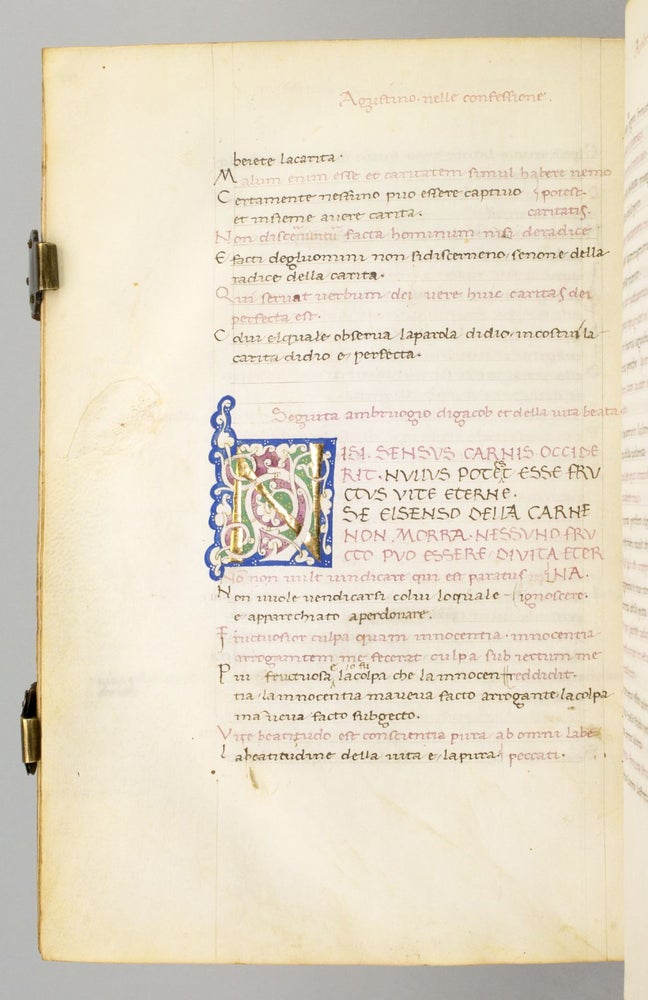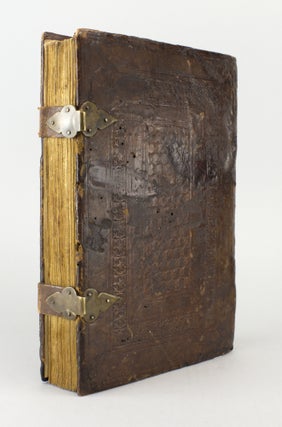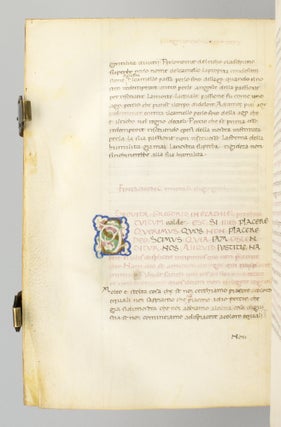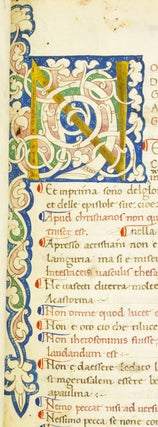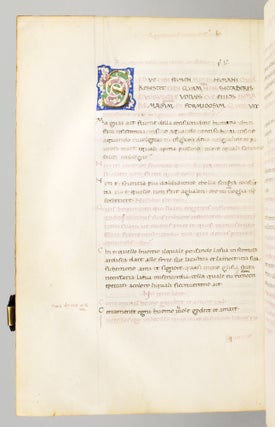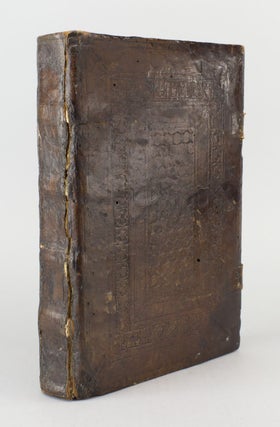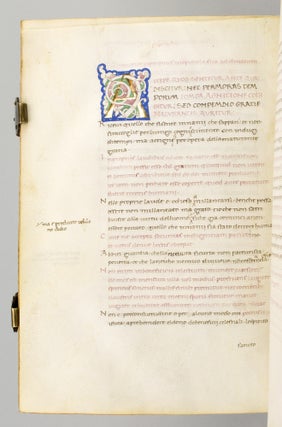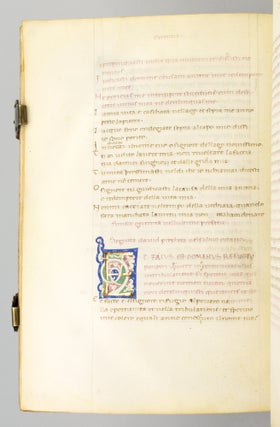NOTABILI ET SENTENTIE DI QUATTRO DOCTORI: GERONIMO, GREGORIO, AGUSTINO ET AMRUGIO.
(Italy [Florence]: colophon dated 1456-57). 268 x 187 mm. (10 1/2 x 7 3/8"). 176 leaves, COMPLETE, single column, 31 lines alternating red ink for Latin and dark brown ink for Italian translation, in a very fine humanist hand.
Contemporary Italian panelled calf over wooden boards, cover with mitered frame of blind rules, inner arabesque roll frame, and central panel diapered in ogival compartments formed by interlacing semi-circular rope tools, raised bands, original clasps replaced with modern hardware, edges gilt and gauffered with chevrons and flowers, expertly rebacked to style. Paragraph marks in red or blue, initial letters of each sentence in contrasting color to main text, running titles in red, 10 ORNATE WHITE VINE INITIALS, the first two very large and extending quite far down the page, the letters burnished gold and skillfully linked with white vines against a pink and green background outlined with blue and further decorated with clusters of white dots (the drawing of a crowned female head in the margin of one page). Front endleaf with 17th or 18th century signature of Eduardo Lopez, dated colophon on final page, rear pastedown with a 19th century English price code in pounds and shillings. ◆Front joint cracked (but no looseness), leather with a few small wormholes, binding with general wear and significant (careful) restoration, but still retaining much of its original appeal; red ink not infrequently faded to varying degrees (though never illegible), a few light scuffs or thumb smudges on the title and the occasional leaf, otherwise in thoroughly excellent condition, entirely fresh, quite clean, and with ample margins.
This beautifully crafted work contains a dated but unpublished text that was compiled for the private edification and elevation of an unknown patron obviously with considerable means, clearly with a desire to attain greater understanding, and apparently without the classical learning typically needed for ready access to it. The manuscript contains excerpts from five books of the Bible (Isaiah, Jeremiah, Job, Psalms, and Proverbs) as well as various texts written by four of the Latin Church Fathers. These include Jerome, "Epistles" (ff. 46r-130v) and "Homilies on Ezechiel" (ff. 130v- 53r); Augustine, "City of God" (ff. 135r-140r) and "Confessions" (ff. 140v-146v); Ambrose, "De Iacob et Vita Beata" (ff. 146v-150r); and Cyprian, "Ad Donatum" (ff. 150v-151r). Each excerpt is presented in the original Latin followed by the Italian translation in contrasting ink, making this not only an object of great interest from a scholarly standpoint, but also aesthetically very pleasing to look at. While the compiler of the text remains anonymous, the manuscript has recently been identified as a sister copy of Rossi MS 88 at the Accademia Nazionale dei Lincei, and MS 335 of the Biblioteca Riccardiana, (both of which manuscripts are without dates). The Riccardiana MS can be placed at the Dominican convent of San Marco in Florence by the mid-16th century at the very latest. Given this early association, it seems quite possible that the editor here would have been connected to the convent in some significant way. The Riccardiana manuscript is notably smaller than the present one, and its more modest dimensions would have been suitable for an inmate at the convent. By contrast, the larger, more opulent version seen here (and in the Rossi MS) would have been more appropriate for the use of a wealthy patron. The convent of San Marco did not lack for illustrious connections and was itself an important center for art and culture in the Medici-ruled Florence of the 15th century. Its status was in no small way bolstered by the efforts of the great patron of the arts Cosimo il Vecchio de' Medici (also known as "the elder"), who not only kept a cell on the premises, but also took it upon himself to renovate the aging structure. Among the notable artists who contributed to its renewal were the sculptor and architect Michelozzo (d. 1472) and painter Fra Angelico (d. 1455); it was also the site of the first public library in Florence. The Medici connection is further evident in the Rossi MS, which contains an ownership inscription of a senior Medici court official. Being a match for our copy in both size and lavishness, it is entirely possible that the manuscript offered here was destined for similarly noble hands. The fact that our text appears both in Latin and the vernacular further indicates an original owner whose birth may have been high but whose education might not have included the exacting Latin study of the ecclesiastic (in any case, the diglot text is an unusual feature of the manuscript, whoever owned it). The materials and decoration of our binding indicate an Italian origin. The binding design here is identical to that on a manuscript of the "Libellus contra Legem Saracenorum" (a refutation of Islam) dated 9 April 1442, (Sotheby's, 18 June 1991, lot 82) which had a partially-effaced early ex-libris inscription suggesting a Milanese owner. With an interior that has retained its freshness and visual appeal, including a fine hand, skillfully designed glittering initials, and wide margins, this particular manuscript provides both an excellent specimen of the Italian Humanist period and a testament to this extraordinary time with its extraordinary patrons. (ST13058)
Price: $125,000.00

